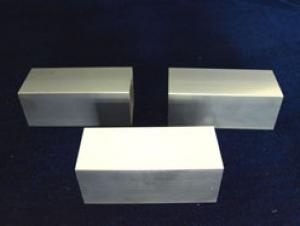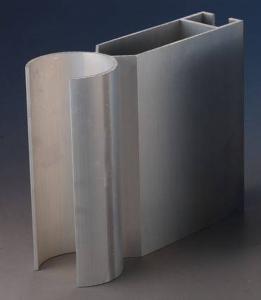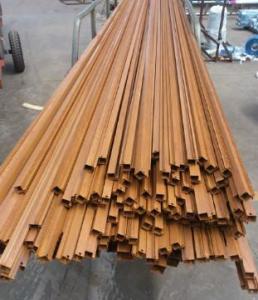Modular Aluminum Profiles Anodizing with Different Colors
- Loading Port:
- Guangzhou
- Payment Terms:
- TT OR LC
- Min Order Qty:
- 5 m.t.
- Supply Capability:
- 1000 m.t./month
OKorder Service Pledge
OKorder Financial Service
You Might Also Like
Specification
1.Structure of Aluminium Profile Anodizing with Different Color Description:
Anodizing (also spelled anodising, particularly in the UK and Australia) is an electrolytic passivation process used to increase the thickness of the natural oxide layer on the surface of metal parts. Anodized aluminium surfaces, for example, are harder than aluminium but have low to moderate wear resistance that can be improved with increasing thickness or by applying suitable sealing substances.
2.Main Features of the Aluminium Profile Anodizing with Different Color:
High corrosion-resistance;
weather-resistance;
heat-resistance;
alkali-resistance and impact-resistance properties.
3.Aluminium Profile Anodizing with Different Color Images:



4.Aluminium Profile Anodizing with Different Color Specification:
1. Material: 6063,6061,6060,6005,6005A,etc.
2. Temper: T5 or T6
3. Finish: Mill finish, anodizing, powder coating, electrophoresis, wooden transfer or pvdf/carbon-flouride coated, polishing, brushing, sand blasting
4. Various colors: Silver, bronze, black, gold, blue, grey, champagne, bright, etc.
5. Machining: Cutting, punching, drilling, tapping, milling, bending, welding, CNC etc.
5.FAQ:
①How about your company?
A world class manufacturer & supplier of castings forging in carbon steel and alloy steel,is one of the large-scale professional investment casting production bases in China, consisting of both casting foundry forging and machining factory. Annually more than 8000 tons Precision casting and forging parts are exported to markets in Europe, America and Japan. OEM casting and forging service available according to customer’s requirements.
②How to guarantee the quality of the products?
We have established the international advanced quality management system,every link from raw material to final product we have strict quality test;We resolutely put an end to unqualified products flowing into the market. At the same time, we will provide necessary follow-up service assurance.
- Q: What are the advantages of industrial aluminum profiles? What are the problems that should be paid attention to?
- Among a large number of aluminum processing materials, a large number of international advanced products and national famous brand products have emerged, representing the mainstream of the development and application of modern aluminum processing technology in china.
- Q: Explain the various methods used to install aluminum profiles in construction projects.
- <p>There are several methods to install aluminum profiles in construction: 1. Bolting: Aluminum profiles can be secured with bolts and nuts, providing a strong and adjustable connection. 2. Welding: For permanent and rigid connections, aluminum profiles can be welded together. 3. Adhesive bonding: Using specialized adhesives, aluminum profiles can be bonded together for a secure fit. 4. Clipping: Some profiles come with clip-on connectors that allow for quick and easy assembly. 5. Screwing: Self-tapping screws can be used to join aluminum profiles, providing a strong hold without the need for pre-drilled holes. 6. Mortise and tenon: A traditional woodworking joint that can be adapted for aluminum profiles, creating a tight and secure fit. Each method has its advantages and is chosen based on the specific requirements of the construction project.</p>
- Q: Are aluminum profiles suitable for earthquake-resistant structures?
- Aluminum profiles can indeed be appropriate for structures that can withstand earthquakes. The lightweight and high-strength properties of aluminum offer numerous benefits when it comes to earthquake resistance. Firstly, the high strength-to-weight ratio makes it possible to construct lighter and more flexible buildings, which can better endure seismic forces. This is particularly important because it reduces the overall mass of the structure and lessens the inertia forces during an earthquake. Additionally, aluminum profiles possess outstanding corrosion resistance, ensuring the long-term durability and structural integrity of earthquake-resistant constructions. This is critical as corrosion can gradually weaken the structure, making it more susceptible to seismic events. Moreover, the malleability of aluminum allows for the creation of intricate and customized profiles, enabling architects and engineers to design structures that can effectively absorb and dissipate seismic energy. This flexibility is crucial in earthquake-resistant design because it allows the structure to deform and absorb the energy generated during an earthquake, thus minimizing the impact on the building and its occupants. Furthermore, aluminum is an environmentally friendly material as it is highly recyclable and requires significantly less energy to produce compared to other metals. Consequently, it is an eco-conscious choice for earthquake-resistant structures. Nevertheless, it is important to note that the suitability of aluminum profiles for earthquake-resistant structures depends on various factors, including specific design requirements, local seismic conditions, and the expertise of the engineers and architects involved. As a result, a thorough analysis and evaluation of the particular project requirements and conditions should be carried out before determining the appropriateness of aluminum profiles for earthquake-resistant structures.
- Q: Explain the various uses of aluminum profiles in architectural design.
- <p>Aluminum profiles have a wide range of applications in architectural design due to their strength, durability, and versatility. They are commonly used for curtain walls, which provide a sleek and modern appearance while offering thermal insulation. Aluminum profiles are also used in window and door frames for their lightweight and strong properties, enhancing security and energy efficiency. They are integral in the construction of sun shading systems and louvers, which help control light and heat in buildings. Additionally, aluminum profiles are used in structural components like beams and columns, as well as in decorative elements such as facades and balustrades, offering both functional and aesthetic benefits.</p>
- Q: This question asks whether aluminum profiles can be utilized for creating interior partitions and seeks reasons for their suitability.
- <p>Yes, aluminum profiles can be used for interior partitions. They are favored for several reasons: they are lightweight yet strong, offering durability and stability. Aluminum profiles are also resistant to corrosion, which makes them suitable for various environments. Their ease of installation and low maintenance requirements make them cost-effective. Additionally, they can be easily customized to fit various design needs, and their recyclability makes them an environmentally friendly choice.</p>
- Q: How do aluminum profiles perform in terms of vibration resistance?
- Aluminum profiles are known to have excellent vibration resistance properties. The inherent characteristics of aluminum, such as its lightweight nature and high strength-to-weight ratio, contribute to its ability to dampen vibrations effectively. Aluminum profiles can absorb and dissipate energy generated by vibrations, reducing the risk of structural damage and ensuring the integrity of the overall system. Furthermore, aluminum profiles can be designed with various geometries and cross-sectional shapes, allowing for enhanced stiffness and rigidity. This improved structural stability helps in minimizing the transmission of vibrations throughout the profile, resulting in reduced resonance and vibration amplification. In addition to these inherent properties, aluminum profiles can be further enhanced through various methods, such as extrusion processes and surface treatments. Extrusion processes can shape the aluminum profiles to specific configurations, optimizing their vibration resistance capabilities. Surface treatments, such as anodizing or powder coating, can provide an additional layer of protection against corrosion and wear, further enhancing the longevity and performance of the profiles. Overall, aluminum profiles excel in terms of vibration resistance due to their lightweight nature, high strength-to-weight ratio, and the ability to be customized for specific applications. These qualities make them an ideal choice for a wide range of industries, including automotive, aerospace, and construction, where vibration control is crucial for maintaining product performance and safety.
- Q: What industries commonly use aluminum profiles?
- Industries commonly using aluminum profiles include construction, automotive, aerospace, electronics, furniture, and renewable energy.
- Q: What are the different shapes available for aluminum profile cross-sections?
- Aluminum profile cross-sections come in various shapes, depending on the specific application and requirements. Some commonly used shapes are as follows: 1. Square profiles, with equal sides and right angles, are ideal for applications that prioritize stability and strength, such as structural framing. 2. Rectangular profiles, similar to square profiles but with unequal sides, find utility in a wide range of applications, including enclosures, frames, and supports. 3. T-shaped profiles consist of a central vertical section and a horizontal section extending from one side, resembling the letter "T." These profiles are often employed for joining components or providing additional support to structures. 4. L-shaped profiles, featuring a 90-degree angle, are commonly used as brackets, corner reinforcements, or frame components. 5. Round profiles have a circular cross-section and are frequently utilized for applications that desire a smooth, curved appearance, such as handrails, furniture, or decorative elements. 6. I-beam profiles resemble the letter "I" and consist of a central vertical section (web) and two horizontal sections (flanges). Due to their high strength-to-weight ratio, I-beams are widely employed in construction and structural engineering. 7. U-channel profiles have a U-shaped cross-section and are often used as edge protectors, trim, or guides. They can also function as tracks for sliding doors or reinforcement beams. 8. Hexagonal profiles, with six sides, are suitable for applications that require increased strength and rigidity, such as machinery frames or support structures. These examples represent just a few of the available shapes for aluminum profile cross-sections. The choice of the most appropriate shape depends on the specific requirements of the intended application, ensuring optimal performance and functionality.
- Q: 30*40 how much aluminum meter?
- 30*40 aluminum tube color of grain price is generally about 13.6-19.8.
- Q: Can aluminum profiles be subjected to painting or coating processes to enhance their aesthetic appeal and longevity?
- <p>Yes, aluminum profiles can be painted or coated to improve their appearance and durability. The process usually involves cleaning the aluminum to remove any contaminants, followed by a conversion coating to enhance adhesion. After that, a primer is applied, and finally, the paint or coating is applied. This not only enhances the visual appeal but also protects the aluminum from corrosion and wear, extending its lifespan.</p>
Send your message to us
Modular Aluminum Profiles Anodizing with Different Colors
- Loading Port:
- Guangzhou
- Payment Terms:
- TT OR LC
- Min Order Qty:
- 5 m.t.
- Supply Capability:
- 1000 m.t./month
OKorder Service Pledge
OKorder Financial Service
Similar products
Hot products
Hot Searches
Related keywords




























